Valencia combines everything we love about Spain and throws it together to create something every bit as deliciously fresh as its signature paella dish. Seemingly overshadowed by Barcelona and Madrid, the Spanish city may not boast as many iconic attractions as its bigger siblings, but instead serves a more authentically Spanish experience.
Valencia was founded during Roman times, and its long history spans Visigoth rule, the Moorish conquests, and the Spanish Civil War. You can see these influences by wandering through the city's Old Town and through a visit to Valencia's Gothic cathedral, which is said to hold the actual Holy Grail… or so they claim. In stark contrast, Valencia’s most recognisable landmark is the City of Arts and Sciences, a futuristic architectural complex featuring modern museums and attractions that you've no doubt seen featured in just about every sci-fi show known to humankind. And then there’s the beach, of course, complete with a lively promenade and nearby marina—the perfect place to round up a group of friends and devour one of the city's aforementioned paella together on the seafront.
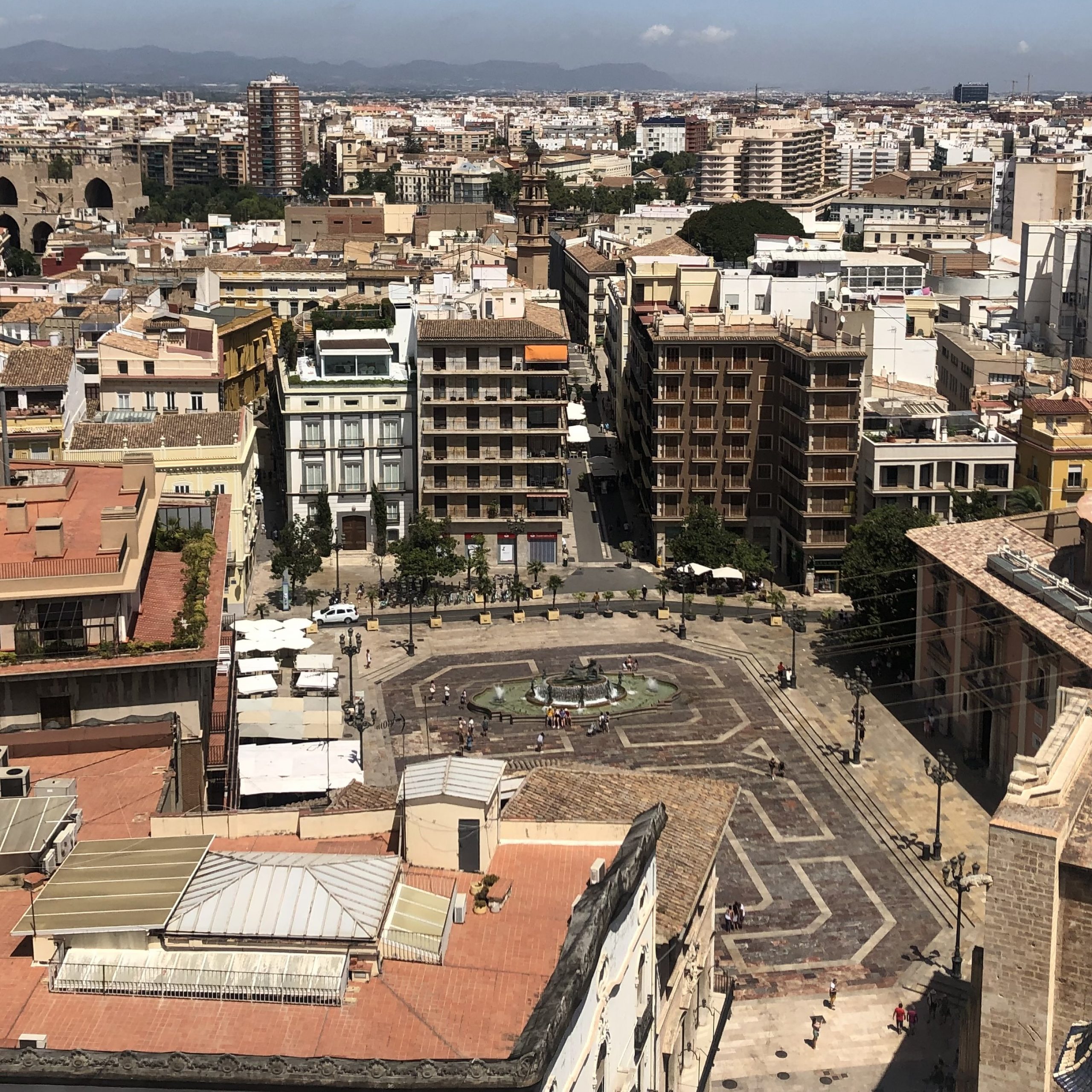
Like much of Spain, Valencia is a liberal city with a vibrant selection of gay bars, cafés, and restaurants—it even had an openly lesbian mayor from 1991 to 2015. This makes Spain’s third-largest city an excellent holiday destination for LGBTQ+ travelers seeking to sink their teeth into Spanish culture while also enjoying some spicy gay nightlife and quality beach time.
Table of Contents
1. General Tips
2. Airport Transfer and Transportation
3. Gay Hotels in Valencia
4. Sightseeing & Activities in Valencia
5. Gay Tours in Valencia
6. Restaurants and Cafes
7. Valencia Gay Bars and Clubs
8. Valencia Gay Saunas & Cruising Bars
9. Gay Beaches in Valencia
10. Gay Events in Valencia
11. Day Trips from Valencia
General Tips
With a mild Mediterranean climate and over 300 days of sunshine a year, it’s no wonder Valencia is home to so many Spaniards. Given the amount of sunlight Valencia receives, the sea can be warm enough for swimming from around April through as late as November. This means the best times to visit are April/May or September/October to enjoy the beach without the heat and crowds of midsummer. That said, if beach time isn’t important to you, visiting during Valencia’s mild winters will mean fewer tourists and cheaper hotels.
As for where to stay in the city, you can’t really go wrong. The most LGBTQ+ areas are El Carmen and Ruzafa, both of which have lively nightlife scenes, great places to eat, and are near the center. Valencia is bigger than people expect, but given the superabundance of parks, including one running through the entire middle length of the city, it’s also the perfect city for walking or cycling—just check the distance beforehand. It’s worth noting that the beach is quite a walk from the center but easy to reach via bus or metro.
Siesta is serious business in Valencia, meaning you shouldn’t expect to find many places open around 3–5 p.m. Spanish people eat later (lunch around 2 p.m. and dinner around 9 p.m.), so plan your meals accordingly. Also, lunch is considered the primary meal of the day, with a much lighter dinner. The pace of life is slower, and customer service can often reflect this. In other words, pack your patience and don’t plan on rushing through meals. Paella may be the obvious choice while dining in Valencia, especially because the dish was invented here. There are, however, other rice dishes you may also want to try, including arroz caldoso, meloso, al horno, and a banda. Clams are also a common local seafood featured on many menus. If you're not a fan of seafood, try the traditional Valencian Paella, which actually has rabbit meat instead of fish. Finally, don’t forget to wash it down with “Agua de Valencia,” a popular local cocktail made with orange juice, cava, and other spirits.
Among servers in restaurants and at tourist attractions, English is common, but not among the general populace. Learning a little Spanish before your trip can go a long way. In addition to Spanish, Catalan (referred to as Valenciano in this region and sometimes controversially considered a separate language) is commonly spoken by locals and used in signage across the city. However, everyone also speaks Spanish, so it’s just something to be aware of.
Airport Transfer and Transportation
Valencia can be reached by plane via the nearby Valencia Manises Airport. Connections to the city center can be made by metro, bus, or car/taxi. The metro lines are either Line 5 or 3 and cost €4.80 for a single trip to the center, plus a one-euro charge for the Suma card, which you can use to load trips during your visit.
The city can be explored on foot, especially the center, but it is quite a walk to the beach. Bicycling is another popular mode of transportation, and many hotels even offer on-site bicycle rental services to make it easier to get around. Turia Garden runs through the center of the city, where the river used to be, and is a favored scenic route for cyclists traveling up or down through the city.
Metro and bus options are also woven throughout the city. The metro includes a tram line, but none of it runs 24/7, although it operates later on Fridays, Saturdays, and public holidays. EMT buses are fairly user-friendly but can be confusing for those who don’t speak Spanish or know the city well.
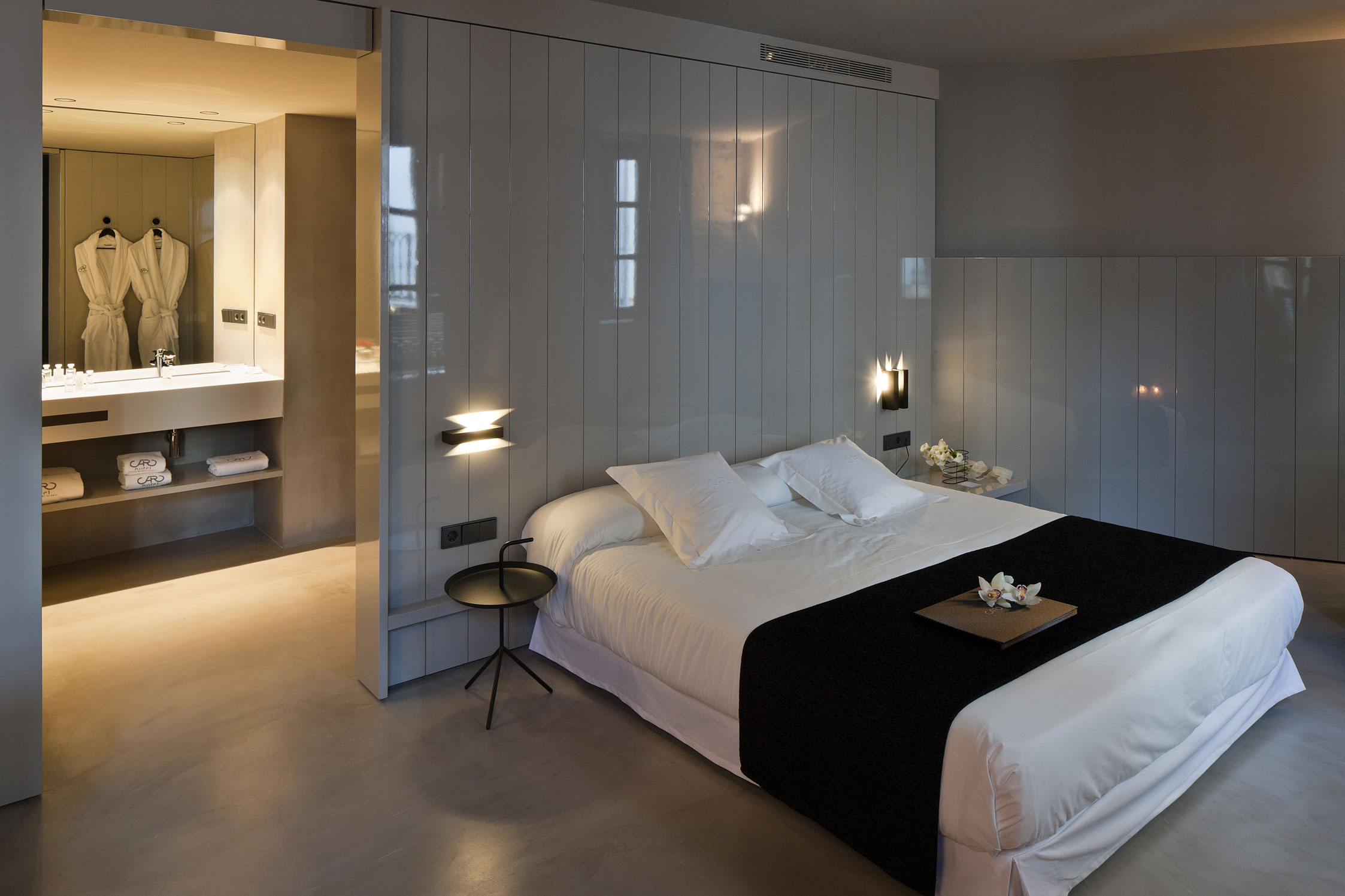
Gay Hotels in Valencia
Luxury
Caro Hotel – The Caro Hotel is perfect for anyone seeking a personalized, luxurious stay near the city center. Built within a 19th-century palace, the Caro Hotel resonates with Spanish history and is limited to only 26 rooms, each unique. Located in the Seu-Xerea neighborhood, the hotel is a short stroll from the Valencia Cathedral and other historic sites. The Alma del Temple restaurant is located on-site in the oldest building in Valencia. Alma del Temple retains a 12th-century Arab wall, adding to the historic ambiance and the menu’s modern interpretation of traditional Valencian flavors. The Caro Hotel also features a swimming pool, a bar, and bicycle rental services.
Only YOU Hotel Valencia – This boutique hotel is located in the heart of the city’s historic center, around the corner from Plaça de l'Ajuntament and the Valencia City Hall, or Ayuntamiento. Nearby historic sites include the Cathedral of Valencia and the Lonja de la Seda (Silk Market building). The Only YOU Hotel also features a cocktail bar, fitness center, and even a florist. The bistro restaurant, located on the hotel’s top floor, offers an “avant-garde” approach to traditional Valencian flavors. The hotel includes a second restaurant, Salvaje, which features Japanese fusion cuisine in a lively atmosphere with a nightly DJ.
Mid-range
Axel Hotel Valencia – The biggest gay hotel chain in the world comes to Valenica within a 17th-century building that was once a dance club in the ’70s. It has spacious balconied rooms, a baroque-style café, a luxurious wellness club, and is just steps away from the center of the city.
Jardin Botanico Hotel-Boutique – Located in Valencia’s Carmen neighborhood, Jardin Botanico Hotel-Boutique is situated near the botanical gardens and the Valencia Institute of Modern Art (IVAM). It features elegant rooms, a trendy bar, and a four-star rating, making it perfect for both leisure and business travelers. The hotel also offers bicycle rental services for guests.
Hotel Zenit Valencia – Hotel Zenit Valencia is situated in the financial center of the city, positioning it close to numerous transport options, including Estación del Norte, the Estación Joaquín Sorolla for high-speed trains, and the Xativa metro station. The Valencia City Hall and the Plaza de Toros are also nearby. Hotel Zenit features a sauna and fitness room at no cost to guests. The hotel offers breakfast in its Azahar restaurant, with items suitable for celiacs/gluten sensitivities and other dietary restrictions.
Budget
Petit Palace Plaza de la Reina – The Petit Palace Plaza de la Reina stands in front of the National Museum of Ceramics and Arts in the historic center of Valencia, with other historic sites like the Central Market, the Turia Gardens, and the Puerta del Mar nearby. The hotel preserves the charm of the old 1930s palace that houses it, boasting rooms that can sleep up to 5 people. The hotel also offers free bicycle rentals, as well as a MIFI service that gives guests access to the internet and free data throughout the city. Pets are welcome at the Petit Palace Plaza de la Reina at no additional charge when booked directly through the hotel.
Hotel Kramer – Located outside the city center, Hotel Kramer is situated in the Campanar neighborhood, just down the street from the Campanar metro station. From the hotel, the city center, including sites like the Central Market and the Quart Towers, can be reached with a 15- to 20-minute walk. The hotel also includes the Kramer Bar, where guests can enjoy a coffee, an unpretentious meal, or dinner with a cocktail. Hotel Kramer also provides bicycle rental services and can arrange transportation to and from the airport. For added convenience, hotel staff can sell you tickets to local sites and attractions, allowing you to skip the lines.
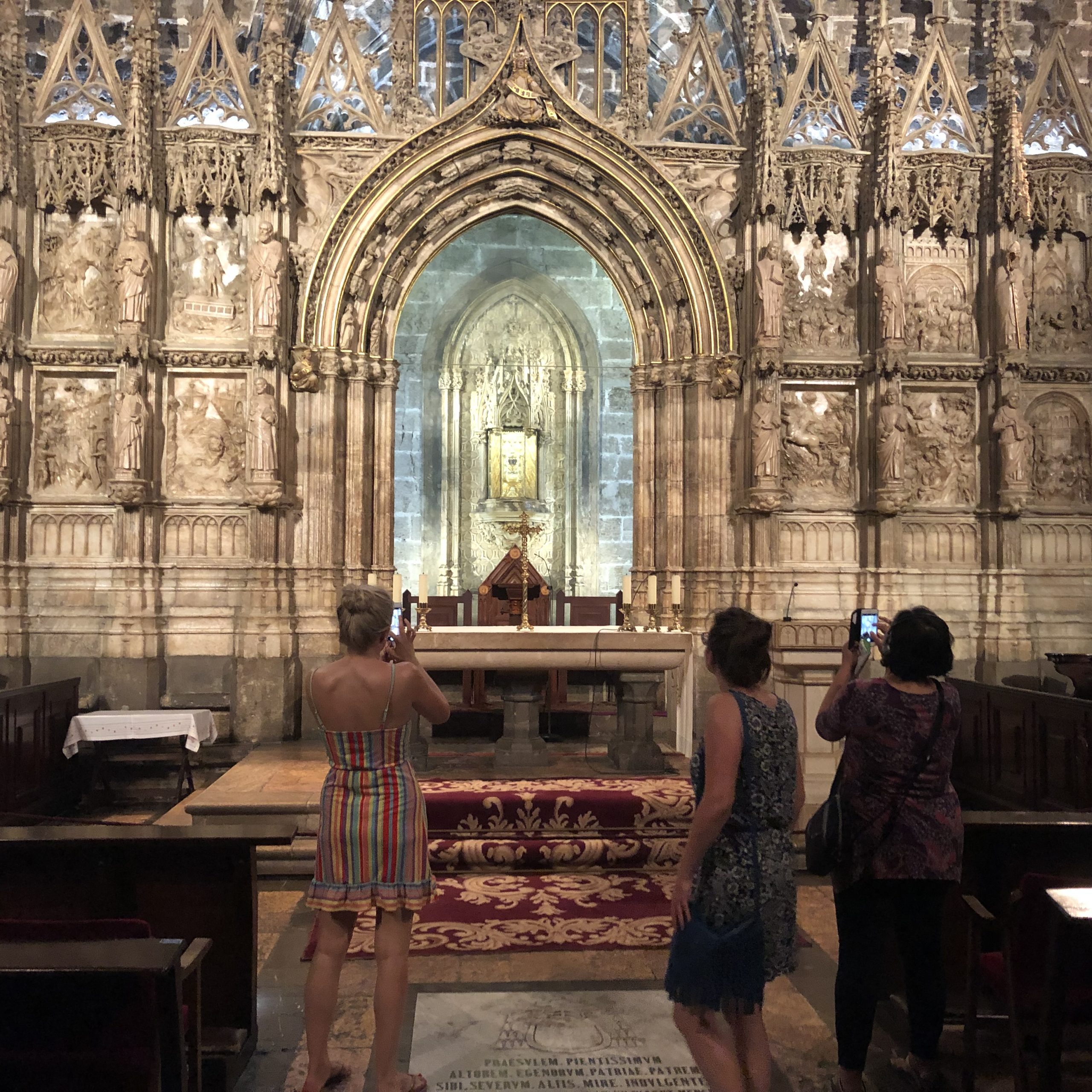
Sightseeing & Activities in Valencia
Valencia Cathedral – Also known as the Cathedral of the Holy Chalice, this building is a stunning example of Valencian Gothic architecture. Over the centuries, it has evolved from a Roman temple into a mosque, and finally into a Catholic cathedral. As the name suggests, it’s especially renowned for housing what is believed to be the Holy Grail, the cup used by Jesus at the Last Supper. It’s a bold claim, to be sure, but go have a look at it and decide for yourself. You’ll also find the desiccated arm of a saint, along with beautiful frescoes and intricate carvings. For a small extra charge, you can climb the famous Micalet bell tower for amazing views of the city below. Book tour →
La Lonja de la Seda (Silk Exchange) – One of Valencia's most iconic landmarks and a UNESCO World Heritage Site, this building is a prime example of Valencian Gothic architecture, featuring intricate stonework, towering columns, and detailed ceilings. Like the cathedral, it was built in the late 15th century and once served as the center of Valencia's thriving silk trade. It is divided into three main sections: the Contract Hall, where merchants negotiated; the Tower, which housed a chapel and cells for detaining dishonest traders; and the Consulado del Mar, an elegant courtroom. Book tour →
The Old Town – Also known as Barrio del Carmen, Valencia's Old Town is a historic district filled with narrow, winding streets. Feel free to get lost within them, as there’s something to see at every turn. This is where you’ll find the aforementioned Cathedral and Silk Exchange buildings, as well as the Basilica de la Virgen church and the Quart and Serrano Towers—relics of ancient Valencia when it was a walled city. There are also many museums within the Old Town, including the National Ceramics Museum, housed in a Rococo-style palace, and the wonderfully detailed archaeological museum. Between sights, take refuge in the area’s lively bars and traditional tapas restaurants. Book tour →
Mercado Central (Central Market) – Located in a stunning Modernist building with beautiful stained-glass windows and ornate tilework, the market is a feast for the senses. It is one of the largest markets in Europe, with over 1,200 stalls offering fresh produce, seafood, meats, spices, and local delicacies. Despite its popularity with tourists, the atmosphere remains authentically local, with many stalls passed down through families for generations. Be sure to sample some manchego cheese or a farton donut dunked in horchata. The central bar is also a wonderful spot to try Valencia’s signature cocktail, Agua de Valencia. Book tour →
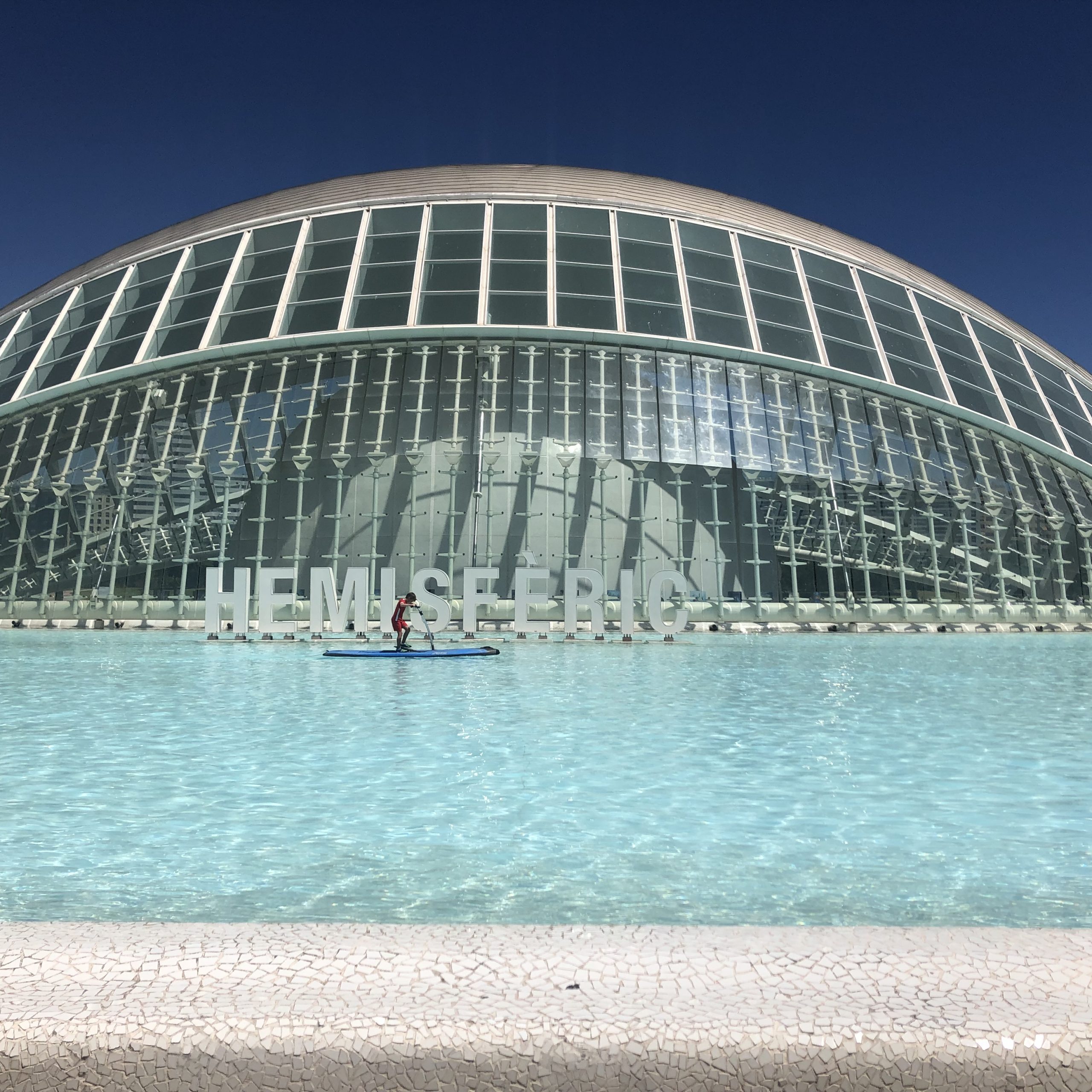
City of Arts and Sciences (CAC) – From the past into the future, the City of Arts and Sciences is a futuristic architectural complex that looks like it came straight out of a science fiction movie and serves as a major cultural and entertainment hub. It includes several key attractions: L'Hemisfèric is an eye-shaped building that houses an IMAX cinema, planetarium, and laser shows. Museo de las Ciencias Príncipe Felipe is an interactive science museum where visitors can explore a wide range of scientific and technological exhibits. L'Umbracle is a landscaped garden and open-air gallery featuring contemporary sculptures. L'Oceanogràfic holds boasting rights as the largest aquarium in Europe, showcasing marine habitats from around the world, including an impressive underwater tunnel. Finally,Palau de les Arts Reina Sofía is an opera house and performing arts center known for its avant-garde design.
Turia Garden – Jardín del Turia stretches over 9 kilometers through the heart of the city. This lush park was created in the former riverbed of the Turia River, which was diverted after a catastrophic flood in 1957. Today, it is a vibrant urban oasis, featuring walking and cycling paths, sports fields, playgrounds, and beautiful gardens. Turia Garden connects several of Valencia's key landmarks, including the City of Arts and Sciences at one end and the historic Bioparc at the other.
Bioparc Valencia – This unique and innovative zoo is located in the northwestern part of the city, near the Turia Garden. Unlike traditional zoos, Bioparc is designed to immerse visitors in the natural habitats of the animals, using barriers like rivers, rocks, and vegetation to create an environment that feels more like a safari than a zoo. The park focuses on African ecosystems, showcasing a wide range of species including elephants, gorillas, lions, and giraffes.
Albufera Natural Park – A serene and picturesque natural reserve located just south of Valencia. It is centered around Albufera, the largest freshwater lagoon in Spain, and is surrounded by rice fields vital to the production of Valencia's famous dish, paella. The park is a haven for birdwatchers, with over 250 species of birds, including flamingos and herons. Visitors can take boat trips on the lagoon, explore walking trails, relax on its beaches, and enjoy stunning sunsets over the water. Take either the 24 or 35 bus from the center for 30 minutes, changing at Embarcadero or El Palmar bus stop. Book tour →
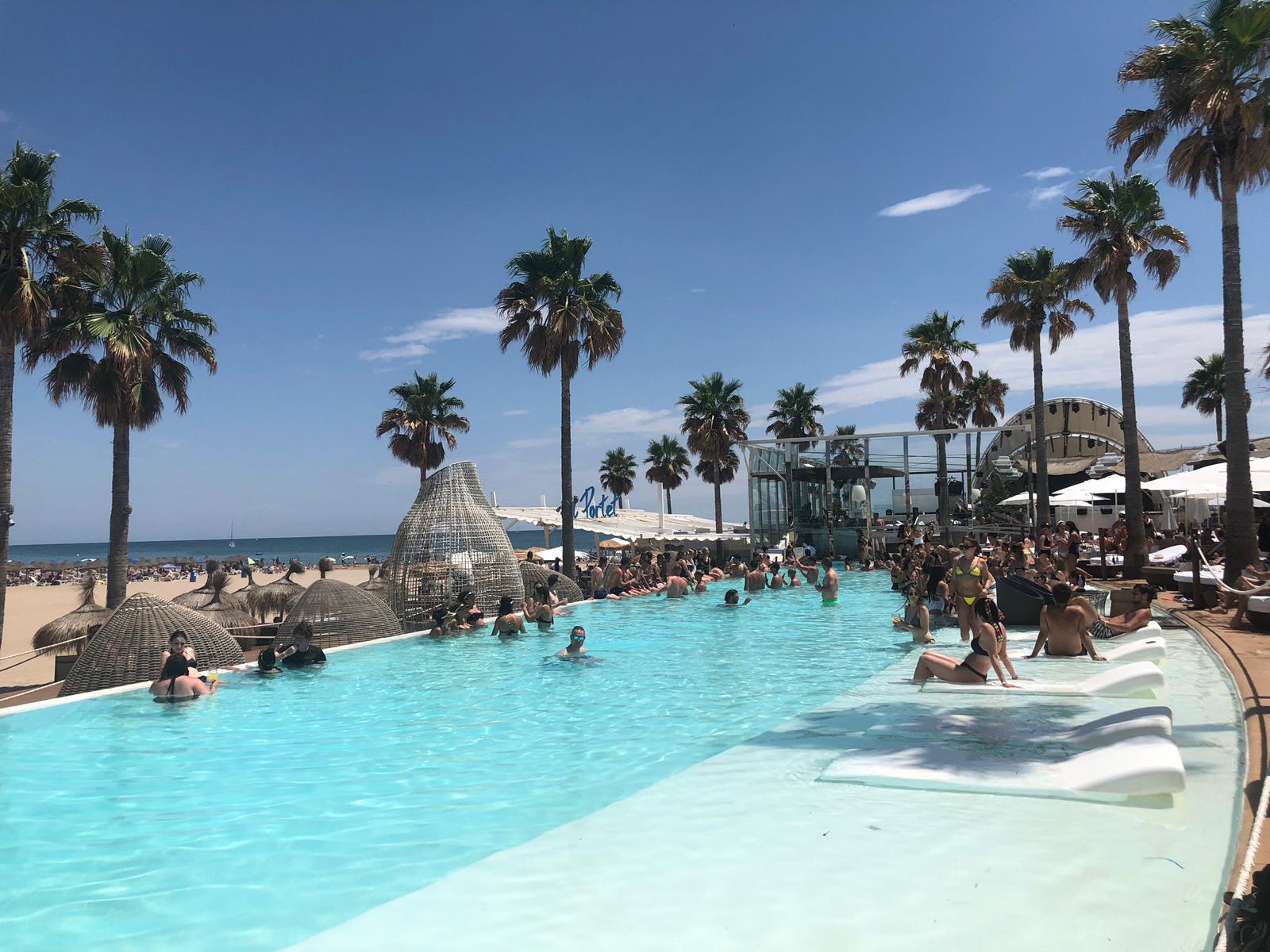
Malvarrosa and Las Arenas Beach – Two of Valencia's most popular urban beaches, Malvarrosa and Las Arenas, are connected and known for their wide stretch of golden sand and clear blue waters. Typically, city beaches aren’t much to look at, but Valencia’s stand out, boasting the Blue Flag Award and the Q for Tourist Quality. Located just a short distance from the city center, these beaches offer a perfect spot for sunbathing, swimming, and various water sports. There are also several upscale beach clubs with pools, like Marina Beach Club, if you’re in the mood for a bit of luxury. The beach is lined with a lively promenade featuring restaurants, cafés, and bars where you can enjoy traditional Valencian cuisine, including fresh seafood and paella.
Valencia Marina – Just off the beach, Valencia Marina complements the seaside experience with its modern facilities for yachting and boating. The marina is a hub for maritime activities, hosting international sailing events and offering a range of dining and entertainment options.
Ruzafa – One of Valencia's trendiest neighborhoods and a favorite among the LGBTQ+ community. Originally a working-class area, Ruzafa has transformed into a cultural hotspot known for its bohemian vibe, eclectic mix of cafés, bars, and restaurants, and a thriving arts scene.
Gay Tours in Valencia
Gaily Tour in Valencia – Gaily Tour offers half-day walking tours within Valencia, as well as full-day excursions from Valencia to surrounding areas on the Spanish coast. Their classic walking tour takes guests through the historic old quarter. Another option is a walking tour of the futuristic City of Arts and Sciences (La Ciudad de las Artes y las Ciencias) and the Oceanogràfic Aquarium. Both tours include all entrance fees in the price. Gaily Tour also offers a nighttime walking tour of Valencia’s LGBTQ+ scene, complete with a drink included in the fare. Their full-day excursions start in Valencia and take guests to destinations such as Sagunto, Segorbe, Xàtiva, or Bejís & Jérica.Book tour →
Gay Tours Valencia – Gay Tours Valencia offers half-day walking tours in Valencia, as well as full-day excursions by bike or bus. These include a customizable private walking tour of the historic city center, a shorter walking tour focusing on Valencia’s medieval quarters, a nightlife walking tour with stops at popular LGBTQ+ bars in the neighborhoods of El Carmen and Ruzafa, and a full-day excursion to Playa Pinedo, a gay nudist beach. Book tour →
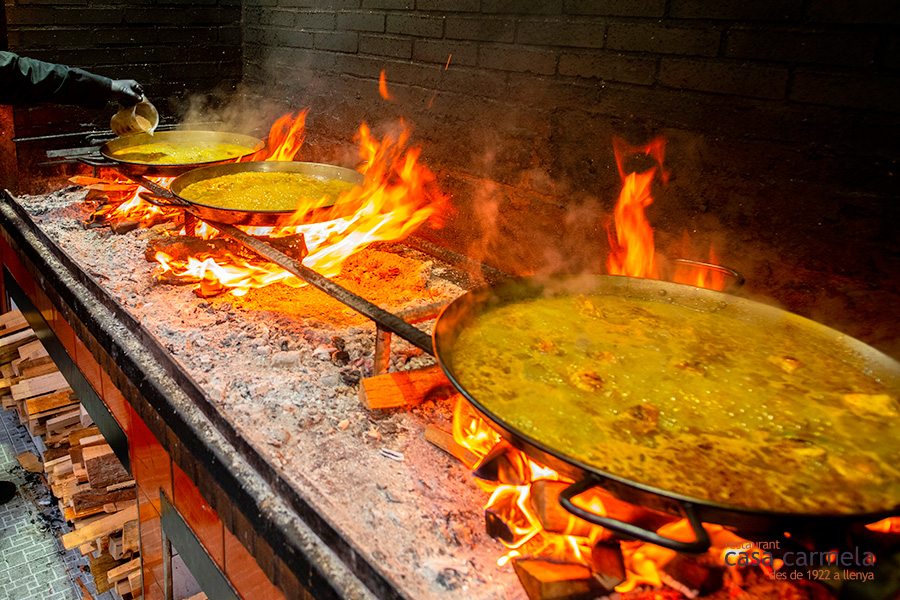
Restaurants and Cafes
Casa Carmela – Cutting straight to the chase: if you’re looking for paella, head down to the picturesque beachfront of Malvarrosa, directly east of the city center. Casa Carmela is renowned for serving the best traditional, wood-fired paella and various other rice dishes. The restaurant has been run and operated by four generations of the same family. Interestingly, it was originally a changing room shack for beachgoers in the 1920s. Outdoor seating is available and recommended, providing diners with the perfect beachfront backdrop while enjoying traditional paella.
Cómic Café – This local Spanish pub in Russafa is especially popular with the local LGBTQ+ community. The menu includes breakfast, brunch, snacks, and drinks on a relaxed outdoor terrace.
Café Trapezzio – Café Trapezzio is a gay-friendly café pub that opens early for coffee and serves drinks and cocktails in the evening as guests lounge on the outdoor terraza. The café is located in a cozy square in the Carmen neighborhood.
Turangalila – An LGBTQ+-friendly restaurant especially known for its dinner with a drag show. Turangalila offers Mediterranean cuisine, featuring dishes like salads, meat and fish entrées, and desserts.
A Fer La Ma – Calling itself a restaurant gastrobar, A Fer La Ma is a popular LGBTQ+-friendly spot located near the botanical gardens in the Extramurs neighborhood. It’s open all day, starting with coffee and breakfast in the morning, and serving dinner entrées and cocktails in the evening. The Spanish/Mediterranean menu is extensive, and there’s plenty of outdoor seating to enjoy it.
Barbarella Drag Show Restaurant – Enjoy a fun night in the Extramurs neighborhood with a delicious dinner, open bar, and cabaret show. Barbarella offers a selection of set menu dinner options, all of which include an open bar and access to the drag cabaret show. The restaurant is open on Fridays and Saturdays only. Reservations can be made in advance and are highly recommended.
La Casa Viva Ruzafa – A vegetarian and vegan restaurant that embodies the principles of reducing, reusing, recycling, and bioconstruction in everything it does. Located in the Russafa neighborhood, La Casa Viva offers a diverse vegetarian/vegan lunch and dinner menu, along with drinks. Consistent with their ethos, even the furniture has been restored using environmentally friendly materials.
Ostras Pedrín Centro – Located on a narrow street in the heart of Valencia, this cozy establishment features a small counter and kitchen, a bar, and a few tables. Despite its snug interior, diners will find a wide selection of oysters, salted fish, gourmet preserves, and salads that pair perfectly with their list of wines and cavas.
Valencia Gay Bars and Clubs
Valencia does not have a designated LGBTQ+ neighborhood, meaning you’ll likely find an LGBTQ+ bar or club near wherever you are staying. However, many popular spots are concentrated in the El Carmen and Russafa neighborhoods.
La Boba y el Gato Rancio – This gay bar is located in the Russafa neighborhood, near Parc Central. It’s a convenient meeting place where you can enjoy drinks and cocktails, coffee, and desserts on their terrace. La Boba y el Gato Rancio also serves a variety of non-alcoholic options, including smoothies, frappes, chai lattes, and milkshakes.
Café de las Horas – A very popular destination that welcomes all visitors, including LGBTQ+ patrons, even if it’s not explicitly LGBTQ+-centric. In addition to a unique menu, guests can enjoy the neo-baroque café interior or sit outside, taking in picturesque views of Valencia Cathedral and its Micalet bell tower. The café is open throughout the day, starting with breakfast and coffee, continuing with afternoon English tea, cakes, and pastries. In the evening, the menu switches to wines and tapas, cocktails, and mixed drinks. It’s a great place to try “Agua de Valencia.”
The Muse – A large gay “disco-pub” with a dance floor located in the La Saïdia neighborhood. The Muse is popular with pre-partiers who often head to the nearby gay nightclub, Deseo 54. (The Muse frequently distributes discount flyers for Deseo 54, so keep an eye out during your visit.)
BUBU – A gay bear bar that attracts men of the hairier variety—or anyone looking to enjoy cheap drinks and great music from the '80s and '90s. BUBU is located in the Extramurs neighborhood, very close to the Torres de Quart and the botanical gardens.
Barberbirborbur Club – Barberbirborbur is a gay-friendly dance club in the Russafa neighborhood that plays hits spanning indie, pop, rock, and disco. It consists of two floors, with plenty of space for dancing. Open Fridays and Saturdays.
Piccadilly Downtown Club – A trendy nightclub drawing a mixed crowd in the heart of the Russafa neighborhood, known for its music selection that includes hits from the '80s, '90s dance techno, rock, pop, and indie. Piccadilly Downtown Club also hosts a special silent disco night where headphones let guests switch between three different music stations—though a DJ still plays for those without headphones, so it’s not truly silent. Open Fridays, Saturdays, and the eve of holidays.
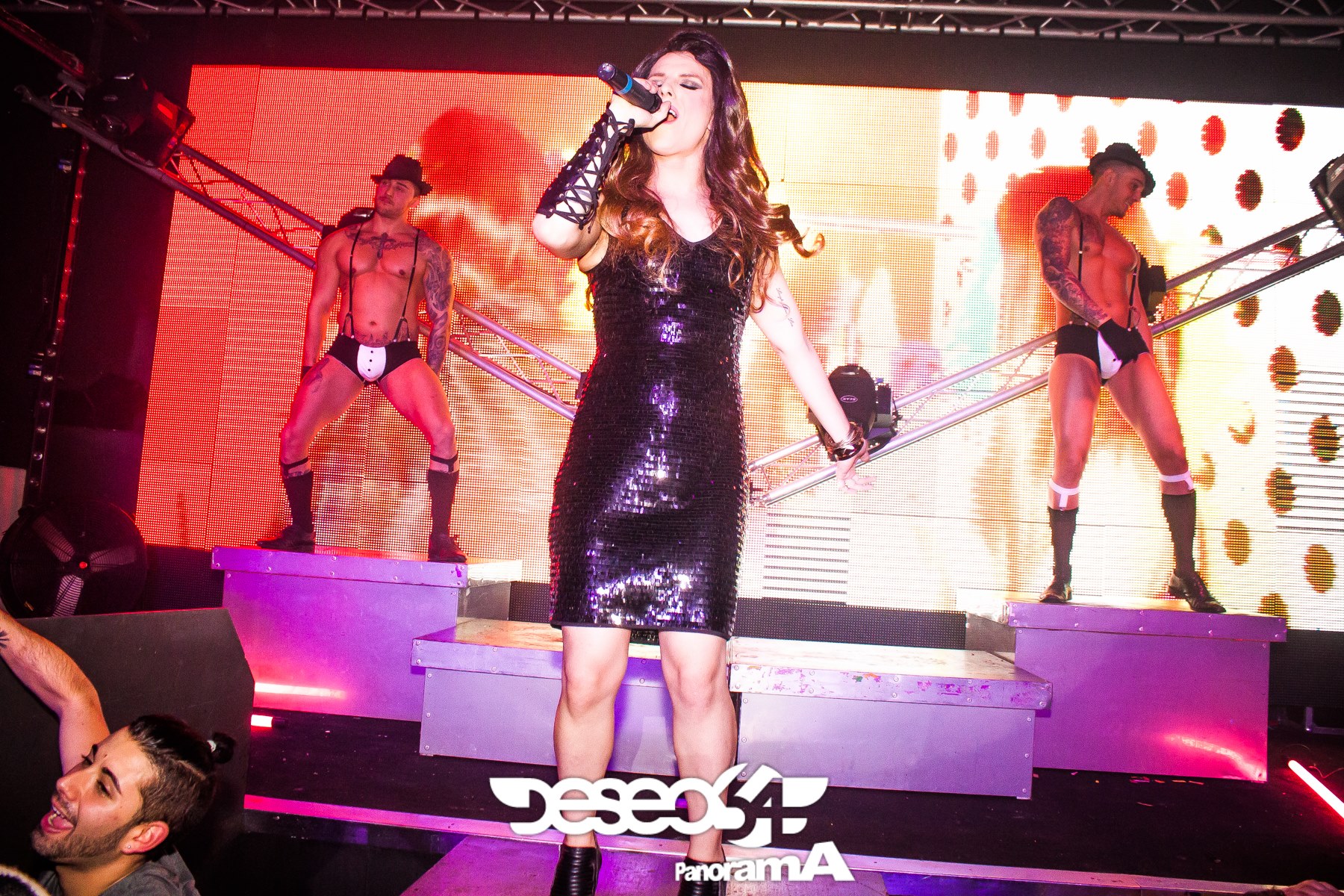
Deseo 54 – A popular gay nightclub playing international house music and often featuring visiting international artists. Deseo 54 is known for its late hours and an impressive display of lighting and special effects. It is situated in the La Saïdia neighborhood, conveniently accessible by foot or public transportation. The club has two floors and features two rooms with different environments and parties.
Fetish Valencia – Despite its name, Fetish Valencia is an after-hours party for LGBTQ+ folks and not a fetish community event (as the name might suggest). Fetish Valencia draws a mixed-age crowd and is especially busy on Sunday mornings. It is typically open on Saturday and Sunday mornings, but be sure to double-check hours.
Valencia Gay Saunas & Cruising Bars
Sauna Olímpic – Centrally located in the Russafa neighborhood, this is one of the busiest saunas in Valencia, particularly on Sundays. Sauna Olímpic features changing rooms, a swimming pool, two giant jacuzzis, dry and steam saunas, a two-floor labyrinth, a dark room, a cinema room X, and a relaxation area. It’s open every day.
Nunca Digo No – This cruising club is smaller than Sauna Olímpic but offers a more intimate, club-like experience. It features showers, glory holes, video booths, dark rooms, swings, private rooms, and labyrinths. Nunca Digo No is located in the Extramurs neighborhood, near the botanical garden and the Quart Towers. Be sure to check the schedule for themed fetish parties (clothed and unclothed), visiting international DJs, and drink specials.
Sexbar Hòmens – Touted as the largest sex bar in Valencia, Sexbar Hòmens boasts a large labyrinth, cabins with beds or stretchers (including double cabins), a video room, glory holes, slings, a large dark room, a golden shower bathtub, showers, and more. The bar also features stripper performances and live sex shows. There’s a lighted area for drinking, chatting, and dancing. Sexbar Hòmens is conveniently located near the València Nord/Valencia North Station. Check their schedule for daily parties; their Sunday parties are especially popular.
Tête-à-tête – A popular gay sauna and cruise bar for locals and visitors, despite being located outside the city center in the Quatre Carreres neighborhood. Tête-à-tête offers themed parties (clothed and unclothed) and features a mega jacuzzi, swings, cabins, lockers, and showers. The venue also has a cocktail bar area with music and conversation, as well as a regular live DJ. An added convenience is their anonymous, private Telegram service, which allows you to plan your night and see how many people are in the sauna before you go.
Gay Beaches in Valencia
Platja de l'Arbre del Gos – The gay, clothing-optional area of this beach includes a popular cruising spot located behind the sand dunes, near an abandoned factory. Today, most of what remains of the factory is its tall chimney, which is easily spotted from the beach and can help guide you toward the area. The closest bus stop to this gay area of Platja de l'Arbre del Gos is “Carretera del Riu – Coll Vert” (lines 24 and 25). Bring extra water, food, and towels, as there are very few services available.
Gay Events in Valencia
Valencia Gay Pride – As a city with a large LGBTQ+ community, Valencia hosts Pride celebrations every June, featuring pre-parties, concerts, LGBTQ+ film and book presentations, theater performances, and other educational and family-friendly events and activities. The festivities culminate in a march beginning on Paseo de la Alameda, proceeding along Colón Street, and ending at Plaza del Ayuntamiento. This year they are also hosting the international Gay Games XII, a massive sports, culture, and diversity festival featuring dozens of sports, art, music, and parties, alongside the traditional city Pride celebrations. Dates: June 27 – July 4, 2026.
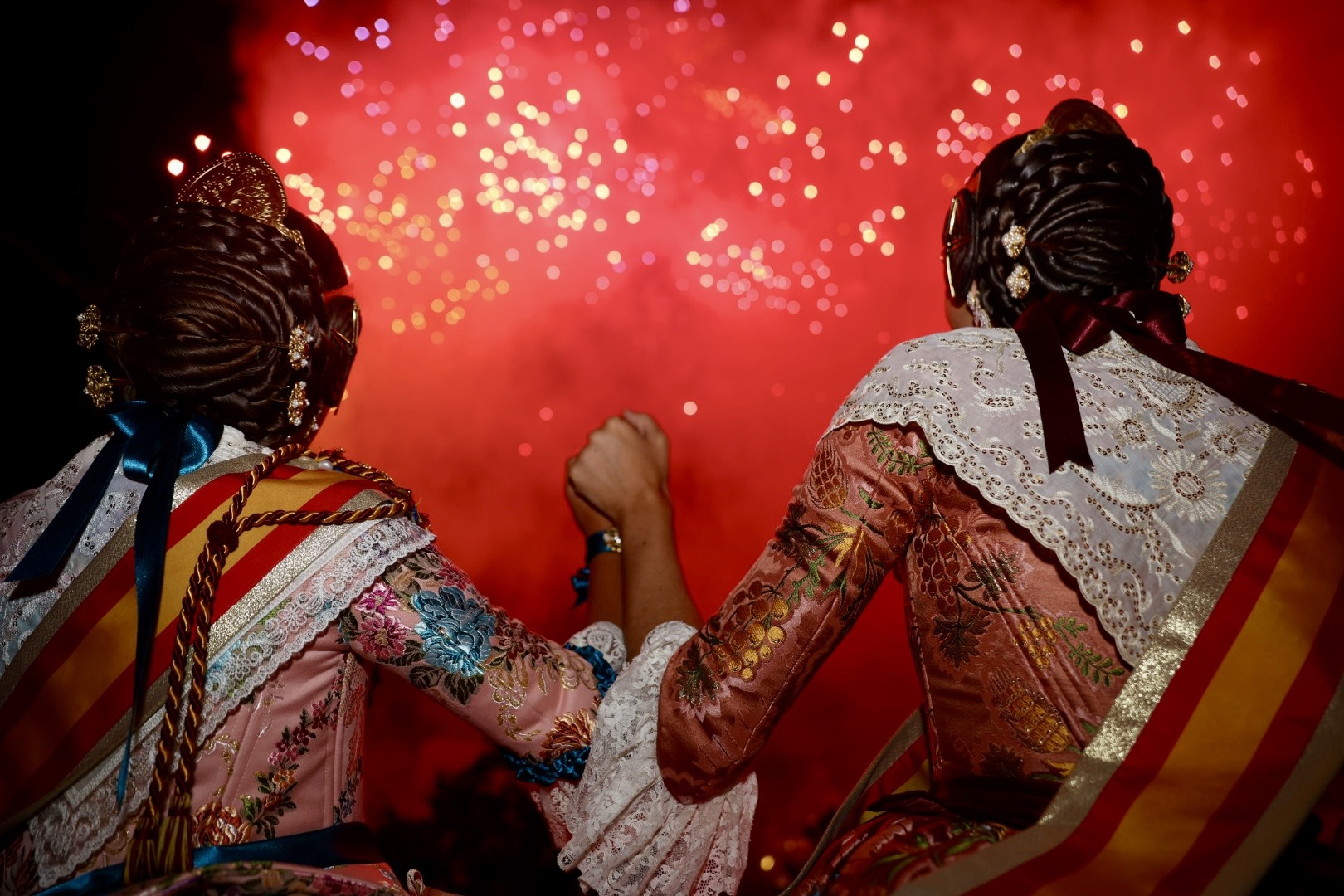
Las Fallas – Not specifically a gay festival, but any guide to Valencia would be remiss not to mention its most famous celebration. Taking place annually throughout the month of March and reaching its climax on the evening of March 19th, the festival features hundreds of towering papier-mâché “fallas” (models of humans) in the streets of Valencia, each taking up to a year to create. Valencia also celebrates Fallas with parades, parties, fireworks, and even bullfighting events. On the eve of St. Joseph’s feast day, March 19th, the fallas are burned in the streets, except for a few chosen by popular vote. Be aware if visiting during this time that fireworks are relentless; if loud noise bothers you, it might be best to avoid Valencia in March. Dates: 1-19 March, 2026.
Madbear Festival Valencia – This festival coincides with the Valencia Fallas festival and spans four days in early March. MAD.BEAR events take place at LGBTQ+ nightclubs, cruising bars, and saunas across the city, including Deseo 54, BUBU bear bar, and Olímpic Sauna. The program also incorporates the Fallas festival’s pyrotechnic show, La Mascletà. Dates: 4 July, 2026.
Valencia Flow Fest – Held annually in May, this festival places Valencia at the center of the international LGBTQ+ scene. Flow Fest’s theme celebrates diversity, expressed through various artistic disciplines. The festival has hosted cultural programs, talks by influential LGBTQ+ icons, and sports exhibitions and championships, such as taekwondo and women’s rugby. Flow Fest also features a diverse lineup of local, national, and international artists performing across multiple stages, focusing on pop, hits, underground, and urban music. Dates: to be announced.
Day Trips from Valencia
Wine Tasting in the Utiel-Requena Region – The Utiel-Requena region encompasses over 100 vineyards, many offering guided wine-tasting sessions and tours of their wine production facilities. Be sure to taste the local Valencian cava, as well as wines made from the native Bobal grapes. While the region grows various grapes, the Bobal grape is the most widely cultivated in Utiel-Requena and is unique to only a few places worldwide. The vineyards are open year-round but are especially lively during the harvest season from August to October. Visit in late August or early September to experience the Requena Harvest Festival and Fair (Fiesta de la Vendimia de Requena), which includes activities like grape stomping. Book tour →
L'Ahuir Nudist Beach – This officially designated nudist/naturist beach, popular with the LGBTQ+ community, is located in the city of Gandia, made famous by the TV show Gandia Shore. Playa de L'Ahuir is notable for its isolated and quiet environment, largely due to the lack of urbanization. Like the rest of Valencia, Playa de L'Ahuir boasts pristine sandy beaches and clean waters. Gandia can be reached by car in about an hour or by train (Cercanías) from Valencia Nord Station.
Buñol – Many visitors know Buñol for its famous Spanish festival, La Tomatina, which takes place annually near the end of August. Literal tons of nearly rotten tomatoes are carried by trucks and flung throughout the town streets, creating one of the world’s biggest food fights. Beyond La Tomatina, Buñol features a 13th-century castle, hiking trails, and waterfalls. One of the most popular is the Turche Cave (Cueva Turche). Buñol can be reached by train (Cercanías) from Valencia Nord Station in about an hour. Book tour →
Montanejos – This municipality is located about 60 miles northwest of Valencia. Known for its stunning natural hot springs, Montanejos offers crystal-clear waters surrounded by lush mountains, ideal for swimming, hiking, and picnicking. The thermal waters maintain a year-round temperature of around 77°F, making it an attractive destination even in cooler months. Visitors can also explore the nearby Caves of San José, Europe’s longest navigable underground river. Book tour →
Note: Some of these links are affiliates which means using them won’t cost you any extra but we do receive a small commission for each referral. You’re not obligated to use them but we appreciate it if you do. Thanks in advance for supporting this site if you choose to use our link!

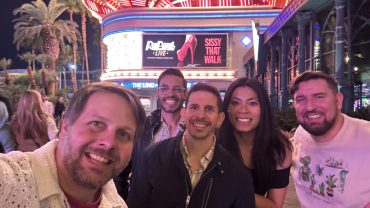
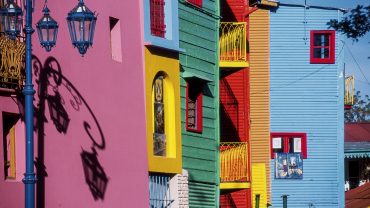

Comment (0)